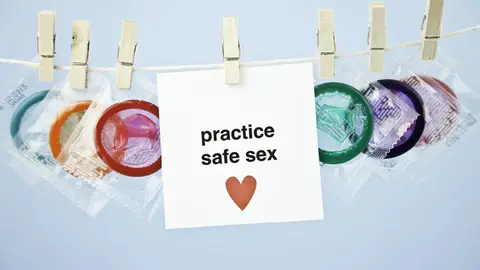Contraception 101

Having sex is great, but having safe sex is better. If you’re not ready to be mummy and daddy just yet then you need need need to be using contraception - and with a whole range of hormonal and nonhormonal birth control out there, there’s really no excuse not to be. Here’s a definitive guide to your options:
The Condom
What is it?
The OG form of pregnancy prevention, A condom is a thin latex sheath designed to fit over a penis just before sex, to stop sperm from entering the vagina. No sperm in vagina = no fertilised egg = no unplanned baby. *fist pump*
How effective is it?
When used correctly, condoms are 98% effective. Condoms that contain spermicide are more reliable, as the chemicals stop the sperm from moving (sort of like an body-bind curse in Harry Potter) then kill them. Oof.
What are the pros?
● Condoms are the only - we repeat, ONLY - contraception that protect you against Sexually Transmitted Infections. When having sex with a new partner, you should always use condoms even if you’re also on another form of birth control. Some couples in monogamous relationships choose to stop using them once they’ve both been tested for STIs and given the all-clear.
● Easily accessible. You don’t need a doctor’s prescription or a procedure - you can pick condoms up from any sexual health or family planning clinic for free. You can also buy them over-the-counter at your local pharmacist if you need to.
And the cons?
● Condoms can break, making them ineffective. Decrease the risk of this happening by leaving a bit of space at the top of the condom, to stop it popping. Pinch the tip between two fingers as it’s placed on the head of the penis, and hold on as it’s rolled down the shaft. Be careful when opening the wrapper too, to avoid causing small rips with your teeth or nails. If you think you may have torn the condom, DON’T USE IT.
● You need to think ahead. Unlike some other forms of contraception, you need to make sure you’re prepared, and always have a condom or two in your bag. Really you should be doing this anyway though, because as we said before - they’re the ONNNNLLLLYYYYYYYYY thing that’ll protect you against nasty STIs.
The Cap
What is it?
A circular dome made of thin, soft silicone, the contraceptive cap is inserted into the vagina before sex - covering the cervix so that sperm cannot enter the womb (YOU SHALL NOT PASS etc. etc. etc.) It must be used with spermicide, and left in place for at least 6 hours after sex. A doctor or nurse will fit you for the correct size and shape of cap for your cervix, then show you how to use it properly with spermicide.
How effective is it?
When used correctly with spermicide, the cap is between 92 - 96% effective at preventing pregnancy.
What are the pros?
● Caps are reusable. Just give it a wash, and you’re good to go again. Eco-friendly AND stress-free.
● There are no serious health risks or side-effects associated with the cap.
● You can put a cap in several hours before sex.
And the cons?
● It doesn’t protect you against STIs.
● It’s not hard to use, but it can take a while to master the technique of getting it in place.
● If you lose or gain more than 7lbs in weight, or have a baby, miscarriage or abortion, you may need to be fitted with a new cap, due to possible changes to the size and shape of your cervix.
The Combined Pill
What is it?
An oral contraceptive that must be taken daily, The Pill contains artificial versions of the female hormones women produce in their ovaries - oestrogen and progesterone. These prevent you from ovulating (that’s when your ovary releases an egg) and also thin the lining of your womb, making it difficult for any egg that is released to implant. The Pill is taken every day for 21 days, before a 7 day break, which is when you’ll have a period-type bleed.
How effective is it?
Are you ready for this? When taken correctly, the Combined Pill is over 99% effective. NICE.
What are the pros?
● When taken every day, it’s hella effective.
● If you have heavy or painful periods, the Combined Pill can help with this. In fact, it’s often prescribed to those suffering with acute period cramps for this reason.
● Contrary to what you might hear - there is NO scientific evidence to support the theory that it causes weight gain.
● Easy to stop whenever you want.
And the cons?
● Can become ineffective if not taken every day, if you are vomiting or have diarrhea, or if you are taking some forms of medication or herbal supplements. ALWAYS check with a doctor or pharmacist if you’re unsure about whether or not you’re protected.
● *Very* low risk of serious side effects, like blood clots and cervical cancer.
● Minor side effects can sometimes include mood swings, sore boobs and headaches.
● Does not protect against STIs.
The Progestogen-Only Pill (POP)
What is it?
Similar to The Combined Pill in that it has to be taken orally every day, the POP only contains the hormone progestogen, not oestrogen (the clue’s in the name). However unlike The Combined Pill, it is taken every day with NO 7 day break period. It works by thickening the mucus in the cervix, to stop sperm reaching an egg, and can also stop ovulation, depending on the type you take.
How effective is it?
Just like the combined pill, the POP is over 99% effective if taken correctly. Cool.
What are the pros?
● Can be used by women who are unable to use contraception that contains oestrogen because they have high blood pressure, a history of blood clots, or are overweight.
● Very effective when taken correctly.
● Easy to stop whenever you want.
And the cons?
● Can become ineffective if not taken AT THE SAME TIME every day. If taken more than 3 hours late (or more than 12 hours with some newer POPs), you risk not being protected against pregnancy. The same is true if you are vomiting or have diarrhea, or are taking some forms of medication or herbal supplements. ALWAYS check with a doctor or pharmacist if you’re unsure, and use a condom too, to be safe.
● Can make periods very irregular and much heavier. Spotting (bleeding in very small amounts) throughout the month is also a possibility.
● Side effects can include spotty skin and sore boobs - although this usually only lasts a few months.
● Does not protect against STIs.
The Contraceptive Implant
What is it?
A small, flexible tube roughly the size of a hair grip (or 40mm long if you wanna get technical about it), that’s inserted by a doctor or nurse, just under the skin of your upper arm. It lasts for three years, and works by slowly releasing progestogen into the body - stopping ovulation, thickening cervical mucus and thinning the womb’s lining. This makes it harder for sperm to enter the womb, and harder for a fertilised egg to attach itself to the uterus wall.
How effective is it?
More than 99% effective. Can we get a hell yeah.
What are the pros?
● If you know you don’t want to get pregnant for a while yet, it’s great - because you’re protected for 3 years after just one insertion.
● Don’t have to worry about remembering to take a pill every day.
● Can be used by women who are unable to use contraception that contains oestrogen because they have high blood pressure, a history of blood clots, or are overweight.
● Not really a pro or a con, but just something to be aware of: a common side effect of the implant is that periods can eventually stop completely, until it is removed.
● Fertility should return to normal as soon as it’s removed.
And the cons?
● Can make periods very irregular, heavier or longer. The NHS says that almost 50% of woman with the contraceptive implant will have infrequent or prolonged bleeding.
● Some medications make the implant less effective - always check with your doctor or pharmacist before you start taking a new medicine.
● If you decide to have it removed, this must be done by a trained doctor or nurse.
● Doesn’t protect you against STIs.
The Contraceptive Injection
What is it?
There’s actually three types of contraceptive injection in the UK: The most popular is Depo-Provera, which lasts for 12 weeks, then there’s Sayana Press, which lasts for 13 weeks, and Noristerat, which lasts for eight weeks. They work because they contain progestogen, which thickens mucus in the cervix to stop sperm reaching an egg, thins the womb lining, and in some cases prevents ovulation. Injection are in your bum cheek, adminstered by a trained doctor or nurse - no DIY jobbies here, thank you v much.
How effective is it?
More than 99% effective, wahoo.
What are the pros?
● Long-lasting, so you don't have to think about contraception every day, or every time you have sex.
● Can be used by women who can't use contraception that contains oestrogen.
● It's not affected by medication, so you don’t need to worry about it not working.
● Some evidence to suggest that it may provide some protection against cancer of the womb and pelvic inflammatory disease.
● Can help with PMS.
And the cons?
● Once it’s in, it’s in: the injection can't be removed once you’ve had it, so if you have side effects they'll last as long as the injection and sometimes for a while afterwards.
● Side effects can include weight gain, headaches, mood swings, sore boobs and irregular or heavier bleeding. Treatment is available if your bleeding is heavy or longer than normal - ask your doctor or nurse if you’re having trouble.
● It can take up to one year for your fertility to return to normal after the injection wears off.
● Depo-Provera affects natural oestrogen levels, which can cause thinning of the bones.
● Does not protect against STIs.
The Contraceptive Patch
What is it?
It’s a small, adhesive patch - a bit like a nicotine patch - that sticks onto your body and delivers hormones into your bloodstream through your skin. Containing the same hormones as The Combined Pill, it works by preventing ovulation, thickening cervical mucus, and thinning the womb lining. Each patch lasts for a week, and after three patches, you have a 7 day break, to allow for a period style bleed.
How effective is it?
It’s more than 99% effective when used properly.
What are the pros?
● You don't need to think about it every day, or every time you have sex.
● It's still effective if you vomit or have diarrhoea.
● You can wear the patch in the bath, in the swimming pool and while playing sports.
● It can help with heavy or painful periods.
● Some evidence to suggest it may protect against ovarian, womb and colon cancer.
● Easy to stop using if you don’t like it - just take the patch off!
And the cons?
● Can increase blood pressure and cause headaches.
● Does not protect against STIs.
● Possible side effects also include nausea, sore boobs, and mood swings for the first fre months.
● Can cause bleeding between periods and/or spotting in the first few cycles of the patch.
● Can irritate the skin slightly to begin with.
The IUD / IUS (The Coil)
What is it?
The Intrauterine Device (IUD) and Intrauterine System (IUS) are two different types of what is commonly known as ‘The Coil’, and can protect against pregnancy for up to 10 years when left in place. An IUD is made of copper and plastic, with the copper changing the balance of the fluids in your womb and fallopian tubes, stopping sperm from being able to survive there. An IUS is made of plastic, and releases progestogen to prevent ovulation. Both are inserted into your uterus by a trained doctor or nurse, with the strings hanging through your cervix into the top of vagina.
How effective is it?
Both are more than 99% effective.
What are the pros?
● Lasts between 5 and 10 years, depending on which type you get - so you don’t have to think about contraception for a loooooong time.
● Neither are affected by other medicines.
● Your normal fertility levels return as soon as the IUD or IUS is taken out.
● An IUS is a good option if you have heavy or painful periods, because it usually makes periods much lighter and shorter, and may even stop them completely after a year or so.
● Useful if you can't take the hormone oestrogen, which is used in the combined contraceptive pill.
And the cons?
● The IUD can make periods heavier, longer or more painful. In fact the most common reasons women choose to have the IUD taken out is due to excessive bleeding and pain.
● Can be mildly painful/uncomfortable when inserted and taken out.
● Some women experience headaches, acne and breast tenderness after having the IUS fitted.
● Damage to the womb: in very rare cases, the IUD or IUS can make a small hole or tear in the womb or cervix as it is inserted. If you feel a lot of pain after having one fitted, as it needs to be treated right away.
● Do not protect against STIs.
The Vaginal Ring
What is it?
The vaginal ring is a small, soft plastic ring that you insert into your vagina, and leave for 21 days. After 21 days, you remove it and chuck it in the bin (NOT THE TOILET), then have a 7 day break for a period-type bleed before inserting a new one for the next 21 days. It works like The Combined Pill, by releasing oestrogen and progestogen.
How effective is it?
More than 99% effective.
What are the pros?
● It’s easy to put in and remove
● You don’t have to think about it every day, or each time you have sex
● The ring (nothing to do with that scary movie) is not affected by vomiting or diarrhea.
● It can help with premenstrual symptoms.
● Periods are likely to become lighter, more regular and less painful.
● Some studies suggest that it may reduce the risk of ovary, uterus and colon cancer.
And the cons?
● You have to be comfortable inserting and removing it from your vagina.
● You have to remember to take it out after 21 days.
● In rare occasions, the ring can fall out if not placed correctly.
● Spotting and irregular bleeding can occur in the first few months of use.
● May cause temporary side effects such as mood swings, sore boobs, vaginal discharge, and headaches.
● Does not protect against STIs.
'- Words by Lizzie Cox'
Now watch this vid of people playing a sexy (and seriously awkward)game ofWould You Rather...





